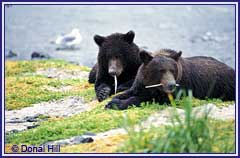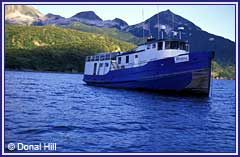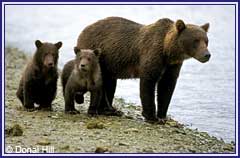|
AUGUST BEARS
by Guest Photographer Don Hill
all photos on this page © Donal Hill
Dear John,
I wanted to write to again say thanks for the incredible experience
you and your crew treated Barb and me to onboard the Waters from
August 18-22. I enjoy wildlife photography and do it as often as
possible -- everything from hummingbirds around our house, to tigers
at the San Diego Zoo, to bull moose in Grand Teton National Park.
This past week's photo expedition in the Katmai fjords, however, was
the most amazing, enjoyable and memorable I have ever experienced.
In fact, the day after you dropped us off at Kodiak, I woke up at
4:45 a.m. in our Anchorage motel room with my head buzzing Katmai
bears. I couldn't get back to sleep, reflecting on our four days on
the Waters, and the bears you took us to.
Donal Hill Coronado, California
 The huge brown bear strode smoothly through the chilly,
rapidly moving stream, then deftly pounced on unseen prey. Grabbing
a struggling salmon firmly in its jaws, it waded directly towards
us, where once on shore a scant ten yards from us, it surrendered
the unfortunate fish to a pair of cubs. The yearling bears rapidly
shredded and devoured the large fish. The female of the species
Ursus arctos returned to the stream and repeated its fishing
activities while the cubs, having polished of their meal, chewed
contentedly on seagull feathers. The huge brown bear strode smoothly through the chilly,
rapidly moving stream, then deftly pounced on unseen prey. Grabbing
a struggling salmon firmly in its jaws, it waded directly towards
us, where once on shore a scant ten yards from us, it surrendered
the unfortunate fish to a pair of cubs. The yearling bears rapidly
shredded and devoured the large fish. The female of the species
Ursus arctos returned to the stream and repeated its fishing
activities while the cubs, having polished of their meal, chewed
contentedly on seagull feathers.
In late summer, the coastal bears seemed to have but one
objective -- to gorge on plentiful pink salmon, running upstream
from the sea to spawn. At Geographic Harbor and near Kinak Bay,
bears of all sizes and ages, preparing for the Alaskan winter,
congregated at shallow tidal estuaries to catch and gorge on
nutritious salmon. August is still a time of plenty for these
extraordinary creatures, and they make the most of their
opportunities, augmenting their protective fat reserves at every
chance. Huge, solitary males, and females with one to three spring
or yearling cubs, prowled the banks and braved chilly streams,
always poised to pounce on unsuspecting fish. In the process, adult
bears are mostly oblivious to the presence of humans, so intense is
their interest in fishing.
 We had traveled to Katmai
to observe bears, but nothing could have prepared us for what we
experienced during an all-too-brief, four-day visit. From the moment
we set foot on M/V Waters, we were immersed in
practically non-stop discussion of bears. Mark Newman, a
part-time-ER physician from Anchorage, was our guide on this trip,
and knows as much as anyone about the brown bears of Katmai. Mark
stressed safety as the paramount concern, not just for humans, but
equally so for bears. Because injury to a viewer from a bear can
lead to destruction of the bear, rules are carefully and repeatedly
explained. In the field, Mark uniformly corrected viewers whose
recall of the rules had slipped, or who had become distracted in the
excitement of the moment. We had traveled to Katmai
to observe bears, but nothing could have prepared us for what we
experienced during an all-too-brief, four-day visit. From the moment
we set foot on M/V Waters, we were immersed in
practically non-stop discussion of bears. Mark Newman, a
part-time-ER physician from Anchorage, was our guide on this trip,
and knows as much as anyone about the brown bears of Katmai. Mark
stressed safety as the paramount concern, not just for humans, but
equally so for bears. Because injury to a viewer from a bear can
lead to destruction of the bear, rules are carefully and repeatedly
explained. In the field, Mark uniformly corrected viewers whose
recall of the rules had slipped, or who had become distracted in the
excitement of the moment.
Our first bear-viewing excursion was nothing less than
astounding. John Rogers ferried our group of seven up a stream off
Kinak Bay in the skiff. After landing at a gravel bar, we strolled
several hundred yards upstream, but saw no bears. But suddenly, a
large sow appeared and began to amble in our direction. We stood
together and silently watched as she passed us at a distance of
about ten to fifteen yards. She proceeded upstream looking for
fishing opportunities, taking little note of us.
 John headed back to the skiff, but then called our attention
to something downstream. Two spring cubs had appeared on the
stream's gravelly bank, where we first saw the sow, their mother. I
evaluated our current situation with some trepidation. Through no
fault of our own, we were now positioned in the danger zone of
legend and lore -- right between a sow and her cubs. As I was
considering our predicament, the cubs' bleating caused the sow to
turn towards us, to reunite with her cubs. Instead of viewing us as
a threat to the cubs, however, she made a wide detour around us,
shuffling through vegetation on the ten-foot-high bank thirty yards
away from the stream. Upon rejoining her cubs, she coaxed them into
following her on her original upstream quest, and again headed our
way. John headed back to the skiff, but then called our attention
to something downstream. Two spring cubs had appeared on the
stream's gravelly bank, where we first saw the sow, their mother. I
evaluated our current situation with some trepidation. Through no
fault of our own, we were now positioned in the danger zone of
legend and lore -- right between a sow and her cubs. As I was
considering our predicament, the cubs' bleating caused the sow to
turn towards us, to reunite with her cubs. Instead of viewing us as
a threat to the cubs, however, she made a wide detour around us,
shuffling through vegetation on the ten-foot-high bank thirty yards
away from the stream. Upon rejoining her cubs, she coaxed them into
following her on her original upstream quest, and again headed our
way.
This sow apparently was accustomed to seeing people, but her
young cubs had only limited experience, if any. They demonstrated
both curiosity and uncertainty towards our group, as the sow again
sauntered by us. One cub, in particular, seemed fixated on our
presence and, despite its mother's nonchalance, would not take its
eyes off us.
The brown bear family shuffled upstream past our tightly
clustered, transfixed group, at a distance of 12 feet. We were
stunned! None of us could ever have anticipated so close an
encounter with such a large and potentially dangerous adult bear,
not to mention a whole family of bears. While the sow and one cub
continued upstream, the fixated cub turned back in our direction,
apparently having given in to its curiosity. It took several steps
in our direction when Mark, in a soft but firm voice told it, "go
on." As he uttered the words, he gently flicked the back of his hand
towards the youngster, which promptly and obediently turned and ran
to catch up with its family.
No two brown bears fish for salmon in the same way. We
observed almost as many different fishing techniques as we did
bears. Bear salmon-fishing methodology ranged from exerting hardly
any energy at all to full-tilt charges up or down stream in a mad
scramble for fish. Experienced bears employed the former method,
which was decidedly superior to the headlong dashes. The two most
effective methods we observed were demonstrated by a large sow with
triplets and a huge, solitary boar. On one occasion, the sow stood
patiently on a grassy, slightly elevated stream bank at Geographic
Harbor, watching for salmon. Suddenly she leaped, spread-eagled into
the stream causing an enormous splash of water. Her head submerged
momentarily. She lifted a large "humpie" from the water, returned to
the bank and presented it to one of her cubs.
The huge boar demonstrated the other highly efficient method.
He had been napping on the gravel bar adjacent to the stream and
arose, shuffling into the water rather nonchalantly. He slowly waded
about, then made a quick plunging motion with his front paws,
pinning his quarry. Grabbing the salmon in his jaws, he ambled onto
the high, vegetated bank and consumed his meal in leisure.
In contrast to these efficient bears, a younger, solitary
adult was a virtual perpetual motion machine. A member of the
head-long-dash school, he was among the most entertaining. When he
spotted a fish from his mid-stream position, he galloped
enthusiastically after it, ending his sprint with a dive and a huge
splash. He repeated this technique until catching a fish. We
observed his behavior for quite a while and, while noting his
inefficiency, had to commend him for pure energy and entertainment
value.
The bear with the most unusual fishing technique was the
snorkeling sow, with cub at the trail position. As we stood by a
curve in a stream where the water slowed and pooled, this sow waded
downstream completely submerged, except for her ears and spine. Her
eyes and snout remained below water for upwards of a minute, as she
searched for her cub's next meal.
The concentration of brown bears along the Katmai coast was
rather astonishing. One day at Geographic Harbor, we simultaneously
observed 14 bears varying in age and size, within a quarter-mile
radius of our position. Although bears are not social creatures, at
Katmai they tolerated each other's proximity while salmon fishing.
Occasionally a sow, believing her young at risk, charged and chased
off a potentially threatening bear, often larger than she.
The Katmai coastal bear experience is simply unforgettable,
and provides unique opportunities for photographers, naturalists and
nature enthusiasts of all experience levels. By following a few
simple rules and the instructions of experienced bear guides,
viewers and bears can safely co-exist. This trip is a must for those
wishing to see Alaska at its wildest.
To Don Hill's photos click
HERE
June Bears |
July Bears
| August Bears
|
September Bears
| Ana's Story |

